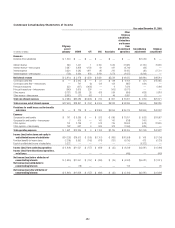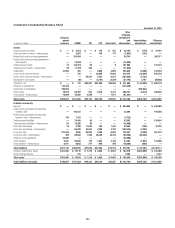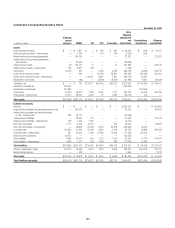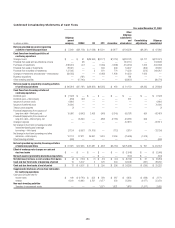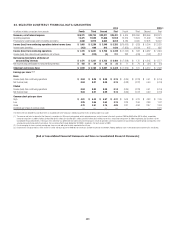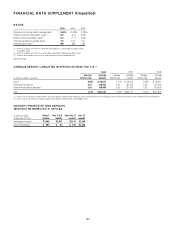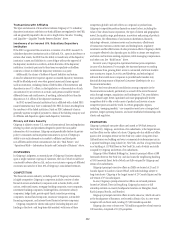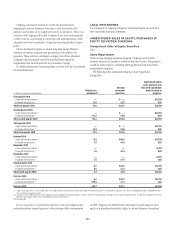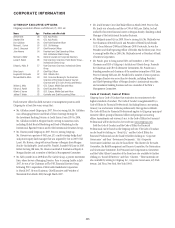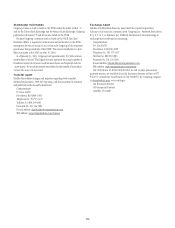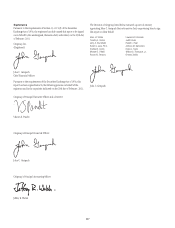Citibank 2010 Annual Report Download - page 304
Download and view the complete annual report
Please find page 304 of the 2010 Citibank annual report below. You can navigate through the pages in the report by either clicking on the pages listed below, or by using the keyword search tool below to find specific information within the annual report.302
Transactions with Affiliates
The types and amounts of transactions between Citigroup’s U.S. subsidiary
depository institutions and their non-bank affiliates are regulated by the FRB,
and are generally required to be on arm’s-length terms. See also “Funding
and Liquidity—Liquidity Transfer Between Entities” above.
Insolvency of an Insured U.S. Subsidiary Depository
Institution
If the FDIC is appointed the conservator or receiver of an FDIC-insured U.S.
subsidiary depository institution such as Citibank, N.A., upon its insolvency or
certain other events, the FDIC has the ability to transfer any of the depository
institution’s assets and liabilities to a new obligor without the approval of
the depository institution’s creditors, enforce the terms of the depository
institution’s contracts pursuant to their terms or repudiate or disaffirm
contracts or leases to which the depository institution is a party.
Additionally, the claims of holders of deposit liabilities and certain
claims for administrative expenses against an insured depository institution
would be afforded priority over other general unsecured claims against
such an institution, including claims of debt holders of the institution and
depositors in non-U.S. offices, in the liquidation or other resolution of such
an institution by any receiver. As a result, such persons would be treated
differently from and could receive, if anything, substantially less than the
depositors in U.S. offices of the depository institution.
An FDIC-insured financial institution that is affiliated with a failed FDIC-
insured institution may have to indemnify the FDIC for losses resulting from
the insolvency of the failed institution. Such an FDIC indemnity claim is
generally superior in right of payment to claims of the holding company and
its affiliates and depositors against such depository institution.
Privacy and Data Security
Citigroup is subject to many U.S., state and international laws and regulations
relating to policies and procedures designed to protect the non-public
information of its consumers. Citigroup must periodically disclose its privacy
policy to consumers and must permit consumers to opt out of Citigroup’s
ability to use such information to market to affiliates and third-party
non-affiliates under certain circumstances. See also “Risk Factors” and
“Operational Risk—Information Security and Continuity of Business” above.
CUSTOMERS
In Citigroup’s judgment, no material part of Citigroup’s business depends
upon a single customer or group of customers, the loss of which would have
a materially adverse effect on Citi, and no one customer or group of affiliated
customers accounts for at least 10% of Citigroup’s consolidated revenues.
COMPETITION
The financial services industry, including each of Citigroup’s businesses,
is highly competitive. Citigroup’s competitors include a variety of other
financial services and advisory companies such as banks, thrifts, credit
unions, credit card issuers, mortgage banking companies, trust companies,
investment banking companies, brokerage firms, investment advisory
companies, hedge funds, private equity funds, securities processing
companies, mutual fund companies, insurance companies, automobile
financing companies, and internet-based financial services companies.
Citigroup competes for clients and capital (including deposits and
funding in the short- and long-term debt markets) with some of these
competitors globally and with others on a regional or product basis.
Citigroup’s competitive position depends on many factors, including the
value of Citi’s brand name, reputation, the types of clients and geographies
served, the quality, range, performance, innovation and pricing of products
and services, the effectiveness of and access to distribution channels,
technology advances, customer service and convenience, effectiveness
of transaction execution, interest rates and lending limits, regulatory
constraints and the effectiveness of sales promotion efforts. Citigroup’s ability
to compete effectively also depends upon its ability to attract new employees
and retain and motivate existing employees, while managing compensation
and other costs. See “Risk Factors” above.
In recent years, Citigroup has experienced intense price competition
in some of its businesses. For example, the increased pressure on trading
commissions from growing direct access to automated, electronic markets
may continue to impact Securities and Banking, and technological
advances that enable more companies to provide funds transfers may
diminish the importance of Regional Consumer Banking’s role as a
financial intermediary.
There has been substantial consolidation among companies in the
financial services industry, particularly as a result of the recent financial
crisis, through mergers, acquisitions and bankruptcies. This consolidation
may produce larger, better capitalized and more geographically diverse
competitors able to offer a wider array of products and services at more
competitive prices around the world. In certain geographic regions,
including “emerging markets,” our competitors may have a stronger local
presence, longer operating histories, and more established relationships with
clients and regulators.
PROPERTIES
Citigroup’s principal executive offices are located at 399 Park Avenue in
New York City. Citigroup, and certain of its subsidiaries, is the largest tenant,
and the offices are the subject of a lease. Citigroup also has additional office
space in 601 Lexington Avenue in New York City, under a long-term lease.
Citibank leases one building and owns a commercial condominium unit in
a separate building in Long Island City, New York, and has a long-term lease
on a building at 111 Wall Street in New York City, each of which are totally
occupied by Citigroup and certain of its subsidiaries.
Citigroup Global Markets Holdings Inc. leases its principal offices at 388
Greenwich Street in New York City, and also leases the neighboring building
at 390 Greenwich Street, both of which are fully occupied by Citigroup and
certain of its subsidiaries.
Citigroup’s principal executive offices in EMEA are located at 25 and 33
Canada Square in London’s Canary Wharf, with both buildings subject to
long-term leases. Citigroup is the largest tenant of 25 Canada Square and the
sole tenant of 33 Canada Square.
In Asia, Citigroup’s principal executive offices are in leased premises
located at Citibank Tower in Hong Kong. Citigroup has major or full
ownership interests in country headquarter locations in Shanghai, Seoul,
Kuala Lumpur, Manila, and Mumbai.
Citigroup’s principal executive offices in Latin America, which also serve
as the headquarters of Banamex, are located in Mexico City, in a two-tower
complex with six floors each, totaling 257,000 rentable square feet.
Citigroup also owns or leases over 76.8 million square feet of real estate in
100 countries, comprised of 12,356 properties.


